Now we’re ready to look at a computational model I developed for a Shakespeare sonnet, 129, “The Expense of Spirit”. When did this work I had no intention of modeling the whole thing, much less implementing a computer simulation of such a model. I just wanted to do something that felt useful – a vague criterion if ever there was one, but nonetheless real – that afforded some kind of insight. In such a model the nodes in a graph are generally taken to represent concepts while the links between them represent relations between concepts, see my earlier post, Gavin 1.2: From Warren Weaver 1949 to computational semantics, for further remarks.
With that in mind, here’s the sonnet with modernized spelling:
1 The expense of spirit in a waste of shame 2 Is lust in action, and till action, lust 3 Is perjured, murderous, bloody, full of blame, 4 Savage, extreme, rude, cruel, not to trust; 5 Enjoyed no sooner but despised straight, 6 Past reason hunted, and no sooner had, 7 Past reason hated as a swallowed bait 8 On purpose laid to make the taker mad: 9 Mad in pursuit and in possession so, 10 Had, having, and in quest to have, extreme; 11 A bliss in proof, and proved, a very woe, 12 Before, a joy proposed, behind, a dream. 13 All this the world well knows; yet none knows well 14 To shun the heaven that leads men to this hell.
Let’s begin at the beginning. The first line and a half is generally taken as a play words. In one sense, expense means ejaculation and spirit means semen, making lust in action an act of sexual intercourse. You can’t get more sensorimotor than that.
But the lines can also be mapped into Elizabethan faculty psychology, in which spirit was introduced as a tertium quid between the material body and the immaterial soul(s). The rational soul exerted control over the body through the intellectual spirit or spirits; the sensitive soul worked through the animal spirit; and the vegetative soul worked through the vital spirit. Madness could be rationalized as the loss of intellectual spirit causing a situation in which the rational soul can no longer control the body. The body is consequently under control by man’s lower nature, the sensitive and vegetative souls. That too is lust in action. But the conception is abstract. It is this abstract lust in action that allows uncontrolled pursuit of the physical pleasures (and disappointments) of sex.
The uncontrolled and unfulfilling pursuit of sex can be expressed as a narrative that is at the core of the sonnet. The first 12 lines direct our attention back and forth over the following sequence of actions and mental states:
Desire: Protagonist becomes consumed with sexual desire and purses the object of that desire using whatever means are necessary: “perjur'd, murderous, bloody . . . not to trust” (ll. 3-4).Have Sex: Protagonist gets his way, having “a bliss in proof” (l. 11).Shame: Desire satisfied, the protagonist is consumed with guilt: “despisèd straight” (l. 5), “no sooner had/ Past reason hated” (ll. 6-7).
We might diagram that narrative sequence like this, where that loop at the top indicates that the whole sequence repeats (the diagrams are simplified from "Cognitive Networks and Literary Semantics"):
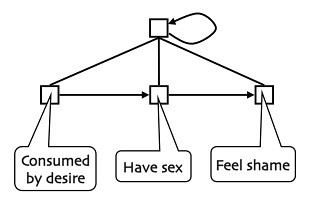 |
| Figure 1: Lust Sequence |
Line 4 looks at Desire (“not to trust”), then line 5 evokes Have Sex followed by Shame. Line 6 begins in Desire then moves to Have Sex, followed by Shame at the beginning of line 7, whose second half begins a simile derived from hunting. Line 10 begins by pointing to Shame, then to Have Sex, then to Desire, thus moving through the sequence in reverse order. It concludes by characterizing the whole sordid business as “extreme.” I leave it as an exercise for the reader to trace the sequence in lines 11 and 12.
Now consider this Figure 2, in which I have taken lines from the poem and superimposed them on the lust sequence with pointers from words in the text to nodes in the network:
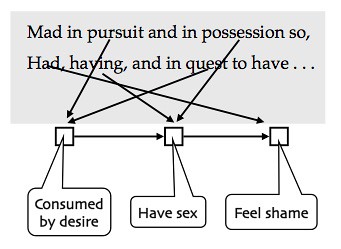 |
| Figure 2: Words and concepts |
Those words ARE the text of Shakespeare’s sonnet. In the diagram they are physically distinct from the mental machinery postulated to be supporting their meaningfulness. Notice that many words are without pointers. The diagram is incomplete, which is obvious at a glance. That’s a virtue, not the incompleteness, but that it is readily apparent. When pursued properly, such models are brutally unforgiving in such matters.
The point is that the meaning of a sequence of signifiers is calculate over/with a network of concepts (signifieds) to which they are linked. That sequence can thus been seen as tracing a path through the network:
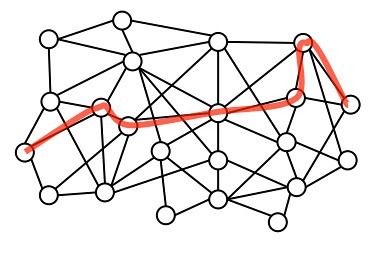 |
| Figure 3: Path through a network |
One understands a language string, whether written or spoken, by assimilating it to a pattern of concepts in a semantic network. That is what it means to calculate meaning. Similarly one speaks by generating a language string from the network, that is, one calculates a string that represents a certain pattern in the network.
Now, consider that simile in lines 7 and 8, in which a person possessed by lust is likened to an animal enraged by poison, poison deliberately laid to achieve that effect. Here’s a diagram:
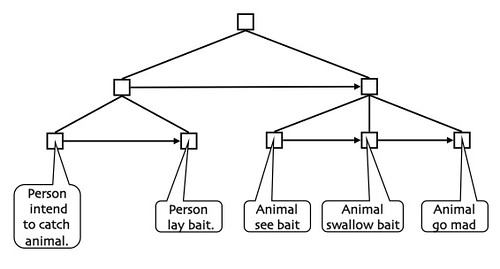 |
| Figure 4: A swallowed bait |
The three episodes at the right conform to the same pattern as the lust sequence in Figure 1. “Animal see bait” is parallel to “consumed by desire”; “animal swallow bait” is parallel to “have sex”; and “animal go mad” is parallel to “feel shame”. But what about that pair of episodes to the left, where the person lays the bait to capture the animal? There’s nothing like that in the lust sequence. But then, the poem doesn’t end with the lust sequence.
The concluding couplet leaves that entire sordid business behind, rises above it, and treats it as an object of contemplation:
All this the world well knows; yet none knows wellTo shun the heaven that leads men to this hell.
It is that whole sordid business that the world well knows. While that knowledge does not exempt us from that sordid business, perhaps there is some solace in realizing that we’re all in this together.
Figure 5 depicts the cognitive structure of the final couplet at the left and the lust sequence on the right:
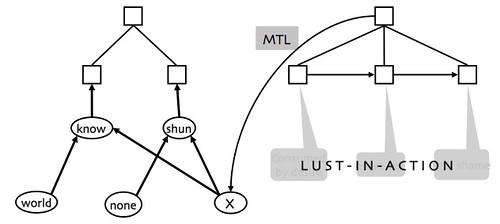 |
| Figure 5: This the world well knows |
Notice that node labeled with an X. Its meaning is given by the lust sequence, all of it. The MTL edge is named after Jakobson’s metalingual function of language: language about language. The world (i.e. everyone in the world) knows something. What? The story of lust. No one is able to shun something. What? The story of lust, that’s what.
The whole diagram is now rather like that in Figure 4, the story of poisoned bait. “Rather like” is not, of course, “exactly like”. But then, this is poetry, not chess, or mathematics. And rather like is good enough. What I’m suggesting is that the simile in lines 7 and 8 – at the end of the second quatrain, by the way, a strategic position in a sonnet – sets the reader up for something in addition to the three-part-lust sequence, something that has a similar relationship to that sequence that the hunter’s action has to consequent madness of the animal that swallowed the bait. That concluding couplet satisfies that expectation. To the extent that one’s knowledge of the lust sequence is unable to prevent that sequence, we can say that that knowledge plays a causal role in that sequence.
It’s not the kind of argument I’d want a propulsion engineer to use. But this isn’t rocket science. It’s poetry. It’s myth. It’s magic, and it’s just fine.
That is an example of computational semantics where computation is part of the process by which meaning is manipulated and communicated, rather than being the process by which data is manipulated for analytic purposes. As I’ve indicated earlier, such models flourished in the 1970s and 1980s, in linguistics, psychology, and artificial intelligence. In particular they were central to investigations of narrative. While such models went out of fashion with the rise of corpus linguistics in the 1990s and after, they’ve not disappeared.
At this point, then, we have three approaches to linguistic meaning before us. We have statistical semantics, vector models in particular, which Gavin employed in his investigation of Milton and we have semantic networks. The third approach is, of course, close reading, for which Gavin used Empson as an example. In the last post in this series I want to compare the three approaches: What can they do? What ontology of the text, and of reading, does each presuppose?
The concept I would want to map first is that of action and its relationship with acting. As the second line seems to read to me, 'is lust in action and until acted on lust.'
ReplyDeleteIt makes the concept of Elizabethan acting look rather interesting as the outward motion here it would seem can be deceptive and trans-formative.